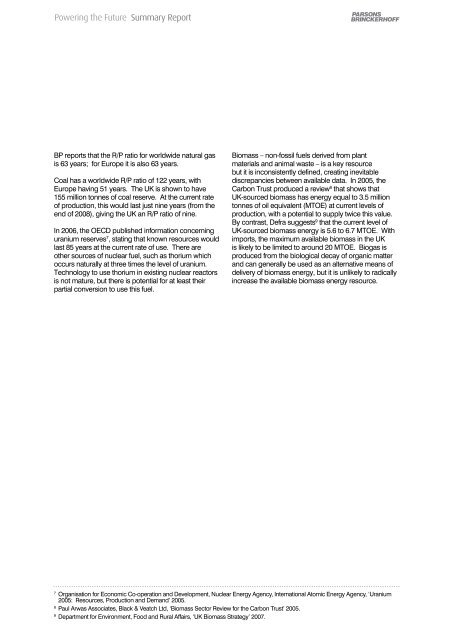Powering the Future Summary Report - Parsons Brinckerhoff
Powering the Future Summary Report - Parsons Brinckerhoff
Powering the Future Summary Report - Parsons Brinckerhoff
Create successful ePaper yourself
Turn your PDF publications into a flip-book with our unique Google optimized e-Paper software.
<strong>Powering</strong> <strong>the</strong> <strong>Future</strong> <strong>Summary</strong> <strong>Report</strong><br />
<strong>Powering</strong> <strong>the</strong> <strong>Future</strong> <strong>Summary</strong> <strong>Report</strong><br />
BP reports that <strong>the</strong> R/P ratio for worldwide natural gas<br />
is 63 years; for Europe it is also 63 years.<br />
Coal has a worldwide R/P ratio of 122 years, with<br />
Europe having 51 years. The UK is shown to have<br />
155 million tonnes of coal reserve. At <strong>the</strong> current rate<br />
of production, this would last just nine years (from <strong>the</strong><br />
end of 2008), giving <strong>the</strong> UK an R/P ratio of nine.<br />
In 2006, <strong>the</strong> OECD published information concerning<br />
uranium reserves 7 , stating that known resources would<br />
last 85 years at <strong>the</strong> current rate of use. There are<br />
o<strong>the</strong>r sources of nuclear fuel, such as thorium which<br />
occurs naturally at three times <strong>the</strong> level of uranium.<br />
Technology to use thorium in existing nuclear reactors<br />
is not mature, but <strong>the</strong>re is potential for at least <strong>the</strong>ir<br />
partial conversion to use this fuel.<br />
Biomass – non-fossil fuels derived from plant<br />
materials and animal waste – is a key resource<br />
but it is inconsistently defined, creating inevitable<br />
discrepancies between available data. In 2005, <strong>the</strong><br />
Carbon Trust produced a review 8 that shows that<br />
UK-sourced biomass has energy equal to 3.5 million<br />
tonnes of oil equivalent (MTOE) at current levels of<br />
production, with a potential to supply twice this value.<br />
By contrast, Defra suggests 9 that <strong>the</strong> current level of<br />
UK-sourced biomass energy is 5.6 to 6.7 MTOE. With<br />
imports, <strong>the</strong> maximum available biomass in <strong>the</strong> UK<br />
is likely to be limited to around 20 MTOE. Biogas is<br />
produced from <strong>the</strong> biological decay of organic matter<br />
and can generally be used as an alternative means of<br />
delivery of biomass energy, but it is unlikely to radically<br />
increase <strong>the</strong> available biomass energy resource.<br />
Figure 4 CO 2 emissions from primary energy sources by sector 10<br />
Figure 5 Breakdown of UK economy fuel use 2006 11<br />
7<br />
Organisation for Economic Co-operation and Development, Nuclear Energy Agency, International Atomic Energy Agency, ‘Uranium<br />
2005: Resources, Production and Demand’ 2005.<br />
8<br />
Paul Arwas Associates, Black & Veatch Ltd, ‘Biomass Sector Review for <strong>the</strong> Carbon Trust’ 2005.<br />
9<br />
Department for Environment, Food and Rural Affairs, ‘UK Biomass Strategy’ 2007.<br />
10<br />
Department for Environment, Food and Rural Affairs, ‘Table 5b: Estimated emissions of carbon dioxide (CO 2) by National<br />
Communication source category, type of fuel and end user: 1970-2007’ 2008.<br />
11<br />
Derived from: Department for Business, Enterprise and Regulatory Reform, ‘DUKES Table 1.3: Supply and use of fuels’ 2008.<br />
11:12

















